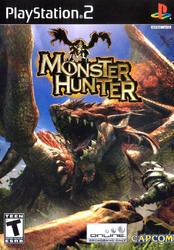Monster Hunter: Difference between revisions
HunterHisty (talk | contribs) No edit summary |
|||
| (6 intermediate revisions by 2 users not shown) | |||
| Line 2: | Line 2: | ||
__NOTOC__ | __NOTOC__ | ||
{{GameInfobox | {{GameInfobox | ||
|English Name= Monster Hunter | |English Name=Monster Hunter | ||
|Image= Boxart-MH1.jpg | |Image=Boxart-MH1.jpg | ||
|Publisher= Capcom | |Publisher=Capcom | ||
|Director= Kaname Fujioka | |Director=Kaname Fujioka | ||
|Release= <small>JP</small>: March 11, 2004<br/><small>NA</small>: September 21, 2004<br/><small>PAL</small>: May 27, 2005 | |Release=<small>JP</small>: March 11, 2004<br/><small>NA</small>: September 21, 2004<br/><small>PAL</small>: May 27, 2005 | ||
|Platforms= Playstation 2 | |Platforms=Playstation 2 | ||
|Flagship=[[Rathalos]] | |||
|Gen=First Generation | |||
|}} | |}} | ||
'''Monster Hunter''' is an online [[Hunting Action|hunting action]] game for the [[PlayStation 2]] console | '''Monster Hunter''' is an online [[Hunting Action|hunting action]] game for the [[PlayStation 2]] console, and the first game in the [[Monster Hunter (Series)|Monster Hunter series]]. | ||
<br/><br/> | |||
After originally releasing on March 11<sup>th</sup> 2004 in Japan, it was released on September 21<sup>st</sup> 2004 in North America alongside a multitude of gameplay changes and overhauls. A PAL region version for Europe followed on May 27<sup>th</sup> 2005. | |||
__TOC__ | __TOC__ | ||
| Line 39: | Line 43: | ||
==Locales== | ==Locales== | ||
''Main article: [[MH1: Locations|Locations in Monster Hunter]]''<br><br> | |||
''Monster Hunter'' featured 7 maps the player could explore and hunt in.<br/>Additionally, it included two peaceful zones: [[Kokoto]] for singleplayer and [[Minegarde]] for multiplayer. | ''Monster Hunter'' featured 7 maps the player could explore and hunt in.<br/>Additionally, it included two peaceful zones: [[Kokoto]] for singleplayer and [[Minegarde]] for multiplayer. | ||
{{-}} | {{-}} | ||
Latest revision as of 16:19, 3 October 2024
| Monster Hunter | |
|---|---|
 | |
| Publisher | Capcom |
| Director | Kaname Fujioka |
| Release | JP: March 11, 2004 NA: September 21, 2004 PAL: May 27, 2005 |
| Platforms | |
| Playstation 2 | |
| Flagship Monster | |
| Rathalos | |
| First Generation | |
Monster Hunter is an online hunting action game for the PlayStation 2 console, and the first game in the Monster Hunter series.
After originally releasing on March 11th 2004 in Japan, it was released on September 21st 2004 in North America alongside a multitude of gameplay changes and overhauls. A PAL region version for Europe followed on May 27th 2005.
Premise & Story
The player takes on the role of a "Monster Hunter", a customizable silent mercenary looking for work in the remote town of Kokoto. Under the guide of the village chief, the player advances through the ranks by slaying powerful monsters and earning money for the village. The singleplayer story concludes with a climactic showdown against a Monoblos.
Gameplay
The gameplay of Monster Hunter revolves around the player hunting monsters, using their materials to craft new armor and weapons, which then allow for the hunting of new, stronger monsters. The player begins each play session by choosing one of two peaceful zones to enter from the games main menu: Kokoto is a village that serves as a hub area for the singleplayer portion, while Minegarde can be visited to partake in online multiplayer. Once in a peaceful zone, the player will use various facilities - such as a smithy or a merchant - to prepare for departure into the games dangerous zones. This may include buying or crafting healing items, commissioning the creation of new armor or procuring of other items that aid in survival. Once ready, the player can set out on a Quest, selected from a curated list based on the players current rank. During Quests, the player must brave the wilderness while aiming to achieve various objectives. These can range from hunting a specific monster to gathering a set amount of a certain resource. Each Quest has a time limit - usually 50 real life minutes - and will end in failure if the timer ends. Additionally, each Quest will only allow the player to faint (lose all their health) a set number of times: Reaching that number will also cause the Quest to fail.
Monster Hunter employs a real-time action combat system, where button inputs from the player immediately translate into movements and actions of the player character. Notably, the players weapons would be controlled via the analog-stick, with different movements corresponding to specific attacks.
The player can choose various weapons to wield, each of which would have a different moveset. These weapons can be switched out at any point in the village or town areas.
In the internationally released version, there are 7 weapon classes available:
- Great Sword
- Sword & Shield
- Dual Swords
- Lance
- Hammer
- Light Bowgun
- Heavy Bowgun
Monsters
Main article: Monsters in Monster Hunter
Monster Hunter featured 13 small Monsters and 17 large Monsters, for a total of 30 Monsters.
Kirin and Fatalis could only be encountered in Multiplayer, while Monoblos was exclusive to the games' singleplayer portion.
Locales
Main article: Locations in Monster Hunter
Monster Hunter featured 7 maps the player could explore and hunt in.
Additionally, it included two peaceful zones: Kokoto for singleplayer and Minegarde for multiplayer.
Development
Description of the games development. Source whenever possible.
Here is how you use sources[1].
Here is how to use[2] the same source multiple times[2].
Regional Differences
Description of any regional differences. Think MH1JP vs MH1US.
Reception
Monster Hunter became known for its naturalistic environments, immersive gameplay, and strategic action gameplay. Despite being a commercial failure in Japan, North America, and Europe, it was a critical success in its home country, winning Grand Prize at the 8th annual CESA Game Awards. Western critics were mixed on the game, with some considering it a solid (albeit niche) experience, and others calling it clunky and criticizing the control scheme.
Trivia
Various fun facts about the game.
- Arranged in a bullet list like this.
Sources